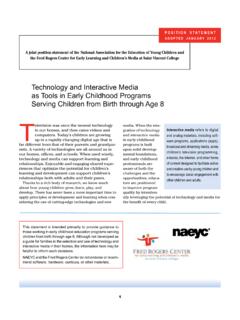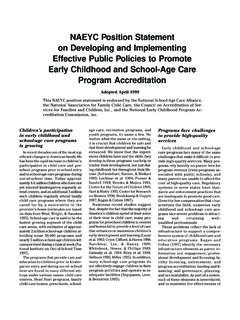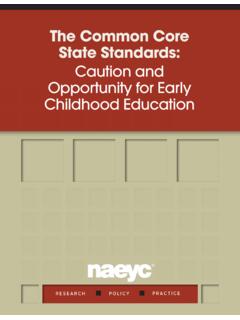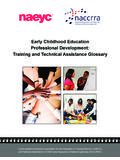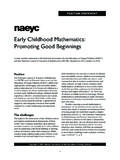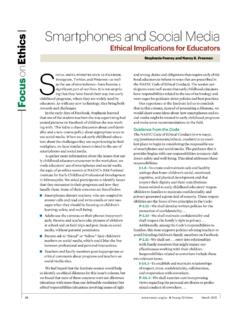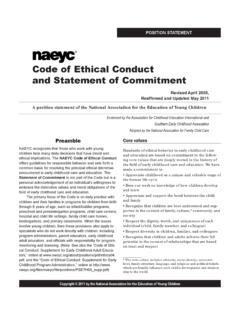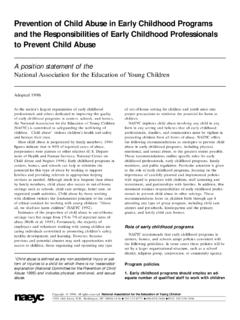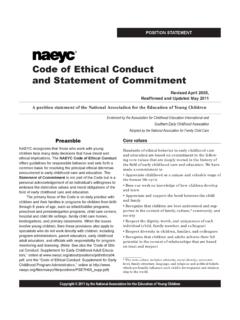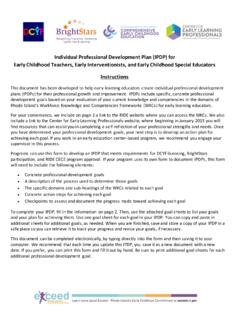Transcription of Best Practices - NAEYC
1 Accreditation Facilitation ProjectsBest Practices ofA Framework for Program Quality Improvement Using NAEYC early childhood Program Standards and Accreditation CriteriaNational Association for the Education of Young Children 1313 L Street NW, Suite 500, Washington, DC 20005tel: (202) 232-8777 (800) 424-2460 Copyright 2010 by the National Association for the Education of Young Children. All rights permission and reprints online at Association for the Education of Young Children 1313 L Street NW, Suite 500, Washington, DC 20005tel: (202) 232-8777 (800) 424-2460 Design: Lindsey Payne DesignPhotography: Susan Woog WagnerAccreditation Facilitation ProjectsBest Practices ofA Framework for Program Quality Improvement Using NAEYC early childhood Program Standards and Accreditation CriteriaKim McClennahan Means ConsultantKMM Consulting, LLC A special thank you to Barbara Willer, Deputy Executive Director, Program Recognition and Support, NAEYC , for her guidance and support in the development of this publication.
2 Alison Pepper Senior Director Accreditation Program Support NAEYC Accreditation Facilitation Project Advisory GroupLinda Hassan Anderson Senior Director NAEYC Academy Former President, BCDI-Atlanta Affiliate Atlanta, GeorgiaGwen Boyd Child and Youth Management Analyst Army Child, Youth & School ServicesGaye Lynn Fisher Senior Educator Hands on Quality Child and Family Resources Tucson, ArizonaDeborah Flis Director Connecticut Accreditation Facilitation Project Rocky Hill, ConnecticutWith gratitude and thanks to Child, Youth & School Services, HQ, Department of the Army, for its generous support of this National Association for the Education of Young Children greatly appreciates the commitment of the Accreditation Facilitation Project Advisory Group members who generously shared their wisdom, expertise, and time in the development of this its publication program the National Association for the Education of Young Children ( NAEYC ) provides a forum for discussion of major issues and ideas in the early childhood field, with the hope of provoking thought and promoting professional growth.
3 Funding for this project was provided in part by the Child, Youth & School Services, HQ, Department of the Army. The views expressed or implied in this book are not necessarily those of NAEYC or the Army. Mary Hayes Director early childhood Accreditation Quality New York New York, New York Nancy Heathman Quality Initiatives Specialist The Family Conservancy Kansas City, KansasJamilah R. Jor dan President Jor dan Consulting Group, Inc. Former President, Partnership for Quality Child Care Chicago, IllinoisPaige K. Whalen Quality Enhancement Initiative Coordinator Child Care Resource Center Community Service Council of Greater Tulsa Tulsa, Oklahomachapter page1 Background 52 Supports to Programs 133 Business Practices of an AFP 334 Community Leadership 475 Conclusions and Appendices 57 Accreditation Facilitation ProjectsBest Practices ofA Framework for Program Quality Improvement Using NAEYC early childhood Program Standards and Accreditation Criteria If you would understand anything, observe its beginning and its development.
4 Aristotle5 Accreditation Facilitation ProjectsBest Practices ofchapter 1 BackgroundIn 1985, the National association for the education of Young children launched the nation s first accreditation system for early childhood care and education programs, setting professionally agreed-upon standards of high quality and providing an independent assessment process to recognize programs that met those standards. By 1990, the first accreditation facilitation projects (AFPs) had emerged spontaneously in various communities across the country, without direct support from NAEYC . The early education leaders in these grassroots projects believed in the power of the new accreditation process. They recognized that programs participating in the process would embark on a journey of program quality improvement that was valuable in and of itself, regardless of the achievement of NAEYC Accreditation.
5 These early AFP leaders also saw that many programs need additional support and encouragement to take full advantage of the voluntary accreditation process as a quality improvement mechanism. Since those first projects began, the number of AFPs and the variety of supports they offer programs have grown immensely. In 2001 AFPs reported 93 facilitation projects in 39 states ( NAEYC 2002). As of April 2010, 156 AFP projects in 37 states and the District of Columbia were registered with NAEYC . Projects operate through public and/or private funding and can be associated with various entities, such as United Way, state quality rating and improvement systems (QRIS), NAEYC Affiliates, and foundations. They typically offer technical assistance: coaching, training, and on-site consultation to support and motivate programs that strive to achieve NAEYC Accreditation as well as programs that might not achieve high quality without their assistance.
6 Although facilitation projects were established and grew independently, NAEYC has long valued and appreciated the role that they play in supporting NAEYC Accreditation. Because AFPs build their quality improvement efforts using the framework of NAEYC early childhood Program Standards and Accreditation Criteria, they provide an important mechanism to strengthen programs. AFPs also help programs assess their readiness to formally apply for accreditation, and they play a critical support role as programs move through the steps of the accreditation process and after accreditation is awarded. The work of AFPs aligns with NAEYC s vision for its accreditation system, which states, NAEYC Accreditation shall be established as a leading force for changing children s well-being and early learning by improving the quality of early childhood programs serving children birth through kindergarten ( NAEYC Program Standards and Accreditation Criteria, 2008, 6)6 Background1 Purpose of this manualThis manual, the first of its kind, is designed to extend the work of successful AFPs by defining best Practices for facilitating NAEYC Accreditation.
7 Just as NAEYC Accreditation defines the mark of quality for programs for young children, this manual describes the best and most effective Practices for motivating and helping programs make lasting improvements in their services to children and families, using the framework established by NAEYC manual identifies key factors for supporting program quality. NAEYC Accreditation represents professional consensus; the Association has always involved an array of stakeholders in shaping and revising its accreditation system. That collaborative tradition continues with this publication. For more than a year, the Accreditation Program Support department solicited information from current and former AFP staff and other stakeholders.
8 In the winter of 2009 an Accreditation Facilitation Project Advisory Group was convened to provide advice and guidance on facilitation work to APS. The group has met on several occasions and led sessions engaging other leaders in the field at NAEYC conferences. Based on these deliberations, the advisory group identified three key areas that together frame best Practices for accreditation facilitation: (1) the supports provided to programs, (2) the business Practices of the facilitation project itself, and (3) the relationships between AFPs and community organizations that promote early childhood program quality improvement and NAEYC chapter is devoted to and details best Practices for each area.
9 Examples of Practices gathered from AFPs across the country illustrate the various ways in which projects may implement best practice. NAEYC s early childhood Program Standards and Accreditation Criteria (2007) define high quality for programs serving young children birth through kindergarten. Parallels from the standards and criteria can be drawn for AFPs. Throughout this manual, accreditation standards and criteria are referenced and, where applicable, slightly modified to convey meaning relevant to AFPs. For example, many of the topics in the Leadership and Management standard directly relate to the administration of an AFP. As AFPs work with programs to understand the standards and criteria, it can be beneficial to consider these parallels (see p.)
10 60). NAEYC defines accreditation facilitation projects as: projects that support quality improvement efforts of child care centers, preschools, and other early childhood programs in many local communities and states and, in an effort to raise program quality, provide technical assistance and support to programs working on NAEYC Accreditation. AFPs motivate programs those working on accreditation and others who are not. AFPs receive guidance and resources from NAEYC s Accreditation Program Support department and participate in the AFP TORCH community. To be eligible, AFPs must serve 10 or more programs in the field, or if the project is in development, intend to do so. A registered AFP has access to discounted accreditation self-study materials and other resources, many of which are outlined Facilitation ProjectsBest Practices ofRelationship between NAEYC and AFPsIn September 2008, the Accreditation Program Support department was established within NAEYC s Program Recognition and Support Division.
